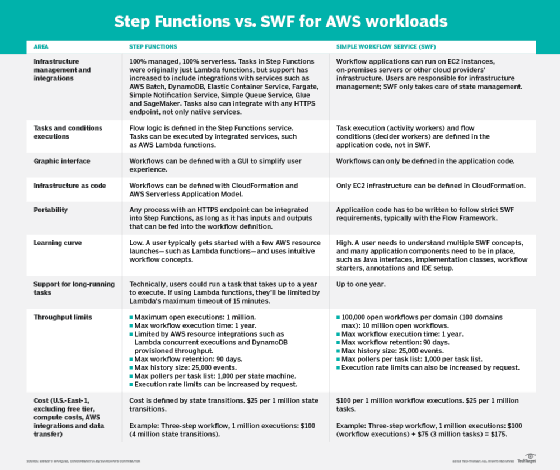
Brian Jackson - Fotolia
Step Functions outshines SWF for most AWS workflows
Simple Workflow Service has been around longer, but Step Functions offers more flexibility for asynchronous tasks. See why the latter is often better for multistep processes on AWS.
Asynchronous tasks are essential to most applications, but it can be a challenge to maintain state with these processes. There are two native options to address this challenge on AWS, though, for most workloads, one is superior to the other.
A developer conducts these types of multistep tasks for regular data updates, to process incoming events or to implement business functions in a certain sequence. Once a workflow starts, they have to keep track of several elements, such as the status of different steps involved, the different conditions that trigger a particular path within a workflow, as well as error handling, retry logic and scale.
For AWS workflows, developers can use Step Functions or Simple Workflow Service (SWF) to manage all of the complexities. Let's compare the capabilities of both to see why Step Functions is likely the better fit for most workloads.
Step Functions vs. SWF
Step Functions coordinates multiple AWS Lambda functions or other AWS resources based on user-defined workflow steps. It keeps track of workflow state in the cloud, as well as flow conditions based on inputs and outputs from each step. Step Functions also helps define error handling, parallel or sequential branching, schedules and retry behavior for all of the workflow steps.
Step Functions is a managed service, so users don't have to deploy or maintain any infrastructure for either the workflow management or the tasks themselves.
SWF also manages workflow state in the cloud. However, unlike Step Functions, a user has to manage the infrastructure that runs the workflow logic and tasks. Tasks can run inside EC2 instances or on any server, including on premises and on other clouds.
The table below highlights some key differences between Step Functions and SWF for AWS workflows:

Most developers will find the Step Functions learning curve to be reasonable. It's easy to define and operate AWS workflows, and the growing list of integrations with other native services expands its use cases, such as long-running AWS workflows, compute-intensive tasks and hybrid cloud deployments.
An organization could potentially opt for SWF as part of a hybrid architecture or if it didn't want to expose internal application components over an HTTPS endpoint, which Step Functions requires to integrate with custom code. But even with those considerations, Step Functions is often the better choice because of lower costs and lack of management requirements.
It also appears that AWS is no longer as focused on SWF, which debuted nearly five years before Step Functions. The Flow Framework recently stopped active development for Ruby, which leaves Java as the only supported framework, and there haven't been any notable upgrades to SWF in the past three years.








